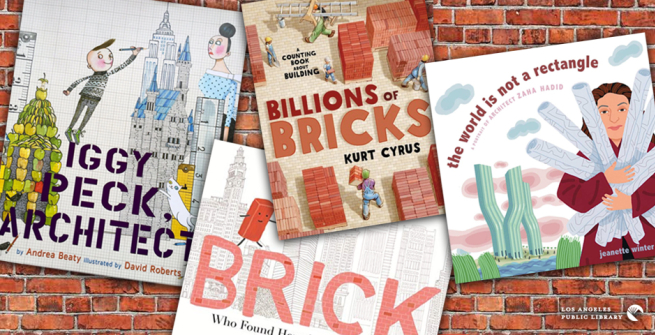“The great thing about architecture is that it’s everywhere,” my father would assert with enthusiasm. He, himself, was a Los Angeles-based architect and it felt nothing short of magical to see his hand-drawn sketches transform over time into three-dimensional spaces. Perhaps these tender childhood memories led me to discover some of the following children’s books chock-full of blueprints, construction materials, and iconic buildings. The books listed below also share a Science, Technology, Engineering, Art, and Math (STEAM) theme which is sure to appeal to young drafters, fort builders, block masters, and tool-belt wearers everywhere.
Fans of Rosie Revere, Engineer, might recognize Iggy Peck, Architect, Rosie’s schoolmate, and fellow out-of-the-box thinker: “Young Iggy Peck is an architect and had been since he was two when he built a great tower—in only an hour—with nothing but diapers and glue.” Illustrated grid lines, rulers, mathematical notations, protractors, and other drafting tools can be found on every rhyming page.
Brick: Who Found Herself in Architecture is an inspiring tale about a little red brick who travels around the globe and back searching to find her place in the world. Readers are treated to an illustrated tour of famous buildings and structures such as Saint Basil’s Cathedral in Moscow and the Great Wall of China during her travels. The little red brick reminds us that “not only do great things begin with small bricks, but great journeys do too.”
Readers of Animal Architects, a nonfiction book, will learn about the intricate nests, dens, and hideouts built by a selection of birds, mammals, and insects. Each page features a few fun facts about a feathered or four to eight-legged architect as well as a materials list, fold-out building plan, and the architect’s signature, or claw print in the case of the African Weaverbird!
The World Is Not a Rectangle is a picture book biography of Iraqi-British architect Zaha Hadid who became well known for her futuristic designs characterized by curving façades and sharp angles. “The world is not a rectangle!” she insisted. Beautifully illustrated examples of her free-form buildings, towers, a bridge, and a ski jump, appear to bend, twist, dip and swirl from page to page.
Good books about designing, engineering, and building are good fun, but if you are looking for even more opportunities to let your young builders go brick-wild, check out the variety of free building programs available at various branches across the city!











